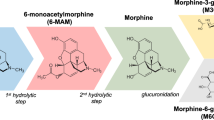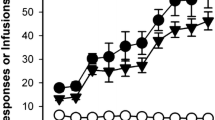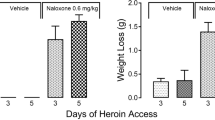Abstract
Rationale
Heroin is rapidly metabolized to morphine that in turn is transformed into morphine-3-glucuronide (M3G), an inactive metabolite at mu-opioid receptor (MOR), and morphine-6-glucuronide (M6G), a potent MOR agonist. We have found that rats that had received repeated intraperitoneal injections of heroin exhibit measurable levels of M6G (which is usually undetectable in this species).
Objective
The goal of the present study was to investigate whether M6G synthesis can be induced by intravenous (i.v.) heroin self-administration (SA).
Materials and methods
Rats were trained to self-administer either heroin (50 μg/kg per infusion) or saline for 20 consecutive 6-h sessions and then challenged with an intraperitoneal challenge of 10 mg/kg of heroin. Plasma levels of heroin, morphine, 6-mono-acetyl morphine, M3G, and M6G were quantified 2 h after the challenge. In vitro morphine glucuronidation was studied in microsomal preparations obtained from the liver of the same rats.
Results
Heroin SA induced the synthesis of M6G, as indicated by detectable plasma levels of M6G (89.7 ± 37.0 ng/ml vs. 7.35 ± 7.35 ng/ml after saline SA). Most important, the in vitro V max for M6G synthesis was correlated with plasma levels of M6G (r 2 = 0.78). Microsomal preparations from saline SA rats produced negligible amounts of M6G.
Conclusion
Both in vivo and in vitro data indicate that i.v. heroin SA induces the synthesis of M6G. These data are discussed in the light of previous studies conducted in heroin addicts indicating that in humans heroin enhances the synthesis of the active metabolite of heroin and morphine.




Similar content being viewed by others
References
Andersen G, Sjogren P, Hansen SH, Jensen NH, Christrup L (2004) Pharmacological consequences of long-term morphine treatment in patients with cancer and chronic non-malignant pain. Eur J Pain 8:263–271
Antonilli L, Semeraro F, Suriano C, Signore L, Nencini P (2003a) High levels of morphine-6-glucuronide in street heroin addicts. Psychopharmacology (Berl) 170:200–204
Antonilli L, Suriano C, Paolone G, Badiani A, Nencini P (2003b) Repeated exposures to heroin and/or cadmium alter the rate of formation of morphine glucuronides in the rat. J Pharmacol Exp Ther 307:651–660
Antonilli L, Petecchia E, Caprioli D, Badiani A, Nencini P (2005) Effect of repeated administrations of heroin, naltrexone, methadone and alcohol on morphine glucuronidation in the rat. Psychopharmacology 182:52–64
Binning AR, Przesmycki K, Sowinski P, Morrison LM, Smith TW, Marcus P, Lees JP, Dahan A (2011) A randomised controlled trial on the efficacy and side-effect profile (nausea/vomiting/sedation) of morphine-6-glucuronide versus morphine for post-operative pain relief after major abdominal surgery. Eur J Pain 15:402–408
Brown GP, Yang K, Ouerfelli O, Standifer KM, Byrd D, Pasternak GW (1997) 3H-Morphine-6beta-glucuronide binding in brain membranes and an MOR-1-transfected cell line. J Pharmacol Exp Ther 282:1291–1297
Christrup LL (1997) Morphine metabolites. Acta Anaesthesiol Scand 41:116–122
Faura CC, Collins SL, Moore RA, McQuay HJ (1998) Systematic review of factors affecting the ratios of morphine and its major metabolites. Pain 74:43–53
Frances B, Gout R, Monsarrat B, Cros J, Zajac JM (1992) Further evidence that morphine-6 beta-glucuronide is a more potent opioid agonist than morphine. J Pharmacol Exp Ther 262:25–31
Fraser HF, Van Horn GD, Martin WR, Wolbach AB, Isbell H (1961) Methods for evaluating addiction liability. (A) “Attitude” of opiate addicts toward opiate-like drugs. (B) A short-term “direct” addiction test. J Pharmacol Exp Ther 133:371–387
Gong QL, Hedner T, Hedner J, Bjorkman R, Nordberg G (1991) Antinociceptive and ventilatory effects of the morphine metabolites: morphine-6- glucuronide and morphine-3-glucuronide. Eur J Pharmacol 193:47–56
Graziani M, Antonilli L, Togna AR, Brusadin V, Viola S, Togna G, Badiani A, Nencini P (2008) Non-opioid induction of morphine-6-glucuronide us is elicited by prolonged exposure of rat hepatocytes to heroin. Drug Alcohol Depend 98:179–184
Gutstein HB, Akil H (2006) Opioid analgesics. In: Brunton LL, Lazo JS, Parker KL (eds) Goodman and Gilman's the pharmacological basis of therapeutics, 11th edn. McGraw-Hill, New York, pp 547–590
Loh HH, Liu HC, Cavalli A, Yang W, Chen YF, Wei LN (1998) μ Opioid receptor knockout in mice: effects on ligand-induced analgesia and morphine lethality. Mol Brain Res 54:321–326
Lotsch J (2005) Pharmacokinetic–pharmacodynamic modeling of opioids. J Pain Symptom Manage 29(5 Suppl):S90–S103
Lotsch J, Zimmermann M, Darimont J, Marx C, Dudziak R, Skarke C, Geisslinger G (2002) Does the A118G polymorphism at the mu-opioid receptor gene protect against morphine-6-glucuronide toxicity? Anesthesiology 97:814–819
Mantione K, Zhu W, Rialas C, Casares F, Cadet P, Franklin AL, Tonnesen J, Stefano GB (2002) Morphine-6-glucuronide stimulates nitric oxide release in mussel neural tissues: evidence for a morphine-6-glucuronide opiate receptor subtype. Cell Mol Life Sci 59:570–574
Markou A, Weiss F, Gold LH, Caine SB, Schulteis G, Koob GF (1993) Animal models of drug craving. Psychopharmacology (Berl) 112:163–182
Martin WR, Fraser HF (1961) A comparative study of physiological and subjective effects of heroin and morphine administered intravenously in postaddicts. J Pharmacol Exp Ther 133:388–399
Matthes HWD, Maldonado R, Simonin F, Valverde O, Slowe S, Kitchen I, Befort K, Dierich A, Le Meur M, Dollé P, Tzavara E, Hanoune J, Roques BP, Kieffer BL (1996) Loss of morphine-induced analgesia, reward effect and withdrawal symptoms in mice lacking the μ-opioid-receptor gene. Nature 383:819–823
Meineke I, Freudenthaler S, Hofmann U, Schaeffeler E, Mikus G, Schwab M, Prange HW, Gleiter CH, Brockmoller J (2002) Pharmacokinetic modelling of morphine, morphine-3-glucuronide and morphine-6-glucuronide in plasma and cerebrospinal fluid of neurosurgical patients after short-term infusion of morphine. Br J Clin Pharmacol 54:592–603
Milne RW, Nation RL, Somogyi AA (1996) The disposition of morphine and its 3 and 6-glucuronide metabolites in humans and animals, and the importance of the metabolites to the pharmacological effects of morphine. Drug Metab Rev 28:345–472
Osborne PB, Chieng B, Christie MJ (2000) Morphine-6 beta-glucuronide has a higher efficacy than morphine as a mu-opioid receptor agonist in the rat locus coeruleus. Br J Pharmacol 131:1422–1428
Pan YX, Xu J, Xu M, Rossi GC, Matulonis JE, Pasternak GW (2009) Involvement of exon 11-associated variants of the mu opioid receptor MOR-1 in heroin, but not morphine, actions. Proc Natl Acad Sci U S A 106:4917–4922
Paul D, Standifer KM, Inturrisi CE, Pasternak GW (1989) Pharmacological characterization of morphine-6 beta-glucuronide, a very potent morphine metabolite. J Pharmacol Exp Ther 251:477–483
Pauli-Magnus C, Hofmann U, Mikus G, Kuhlmann U, Mettang T (1999) Pharmacokinetics of morphine and its glucuronides following intravenous administration of morphine in patients undergoing continuous ambulatory peritoneal dialysis. Nephrol Dial Transplant 14:903–909
Penson RT, Joel SP, Bakhshi K, Clark SJ, Langford RM, Slevin ML (2000) Randomized placebo-controlled trial of the activity of the morphine glucuronides. Clin Pharmacol Ther 68:667–676
Peterson GM, Randall CT, Paterson J (1990) Plasma levels of morphine and morphine glucuronides in the treatment of cancer pain: relationship to renal function and route of administration. Eur J Clin Pharmacol 38:121–124
Romberg R, Olofsen E, Sarton E, den Hartigh J, Taschner PE, Dahan A (2004) Pharmacokinetic–pharmacodynamic modeling of morphine-6-glucuronide-induced analgesia in healthy volunteers: absence of sex differences. Anesthesiology 100:120–133
Rossi GC, Pan Y-X, Brown GP, Pasternak GW (1995a) Antisense mapping the MOR-1 opioid receptor: evidence for alternative splicing and a novel morphine-6β-glucuronide receptor. FEBS Lett 369:192–196
Rossi GC, Standifer KM, Pasternak GW (1995b) Differential blockade of morphine and morphine-6 beta-glucuronide analgesia by antisense oligodeoxynucleotides directed against MOR-1 and G-protein alpha subunits in rats. Neurosci Lett 198:99–102
Sawaya BE, Deshmane SL, Mukerjee R, Fan S, Khalili K (2009) TNF alpha production in morphine-treated human neural cells is NF-kappaB-dependent. J Neuroimmune Pharmacol 4:140–149
Schuller AGP, King MA, Zhang J, Bolan E, Pan YX, Morgan DJ, Chang A, Czick ME (1999) Retention of heroin and morphine-6 beta-glucuronide analgesia in a new line of mice lacking exon 1 of MOR-1. Nat Neurosci 2:151–156
Skarke C, Darimont J, Schmidt H, Geisslinger G, Lotsch J (2003) Analgesic effects of morphine and morphine-6-glucuronide in a transcutaneous electrical pain model in healthy volunteers. Clin Pharmacol Ther 73:107–121
Sora I, Takahashi N, Funada M, Ujike H, Revay RS, Donovan DM, Miner LL, Uhl GR (1997) Opiate receptor knockout mice define receptor roles in endogenous nociceptive responses and morphine-induced analgesia. Proc Natl Acad Sci USA 94:1544–1549
Stain-Texier F, Boschi G, Sandouk P, Schermann JM (1999) Elevated concentrations of morphine 6-beta-d-glucuronide in brain extracellular fluid despite low blood-brain barrier permeability. Br J Pharmacol 128:917–924
Tunblad K, Hammarlund-Udenaes M, Jonsson EN (2005) Influence of probenecid on the delivery of morphine-6-glucuronide to the brain. Eur J Pharm Sci 24:49–57
Ulens C, Baker L, Ratka A, Waumans D, Tytgat J (2001) Morphine-6beta-glucuronide and morphine-3-glucuronide, opioid receptor agonists with different potencies. Biochem Pharmacol 62:1273–1282
Unterwald EM, Pasternak GW, Pintar JE (1999) Retention of heroin and morphine-6β-glucuronide analgesia in a new line of mice lacking exon 1 of MOR-1. Nat Neurosci 2:151–156
Ventura C, Zinellu E, Maninchedda E, Maioli M (2003) Dynorphin B is an agonist of nuclear opioid receptors coupling nuclear protein kinase C activation to the transcription of cardiogenic genes in GTR1 embryonic stem cells. Circ Res 92:623–629
Vermeire A, Remon JP, Rosseel MT, Belpaire F, Devulder J, Bogaert MG (1998) Variability of morphine disposition during long-term subcutaneous infusion in terminally ill cancer patients. Eur J Clin Pharmacol 53:325–330
Walker JR, King M, Izzo E, Koob GF, Pasternak GW (1999) Antagonism of heroin and morphine self-administration in rats by the morphine-6β-glucuronide antagonist 3-Omethylnaltrexone. Eur J Pharmacol 383:115–119
Wang Y, Mitchell J, Moriyama K, Kim KJ, Sharma M, Xie GX, Palmer PP (2005) Age-dependent morphine tolerance development in the rat. Anesth Analg 100:1733–1739
Wielbo D, Bhat R, Chari G, Vidyasagar D, Tebbett IR, Gulati A (1993) High performance liquid chromatographic determination of morphine and its metabolites in plasma using diode-array detection. J Chromatogr 615:164–168
Author information
Authors and Affiliations
Corresponding author
Rights and permissions
About this article
Cite this article
Meringolo, M., Brusadin, V., De Luca, M.T. et al. Induction of morphine-6-glucuronide synthesis by heroin self-administration in the rat. Psychopharmacology 221, 195–203 (2012). https://doi.org/10.1007/s00213-011-2534-7
Received:
Accepted:
Published:
Issue Date:
DOI: https://doi.org/10.1007/s00213-011-2534-7




